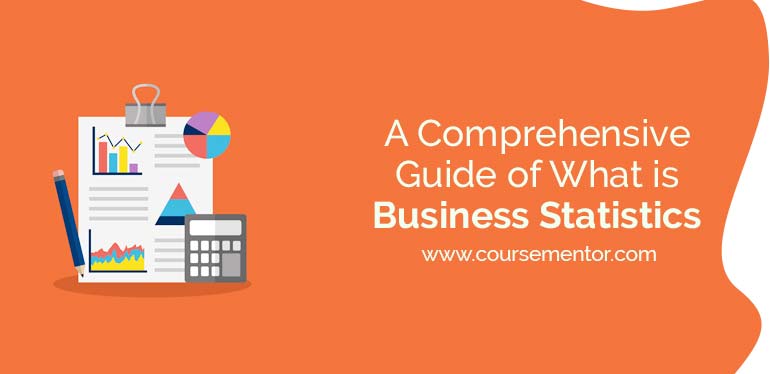Business Statistics Introduction
Every student is wondering about the question: What is business statistics so in today’s post we discuss it.
Business Statistics is the science of Making Decisions on the bases of a lot of analysis in production, auditing, and econometrics. Every right manager makes company growth decisions on behalf of these statistics in times of uncertainty.
To make these decisions, the individual requires following skills like Market Research, Forecasting, Quality Control, Product Planning, Yearly reports, Personnel Management, etc
What are the Types of business statistics:
There are basically two types of methods of statistics. Let’s discuss them
1. Descriptive Statistics
A descriptive statistic is a summarization of data in a useful and meaningful manner. Descriptive statistical analysis is a crucial part that provides you the valuable insights about the data. It contains numerical calculations or graphs or tables.
Descriptive analytics sees what has occurred and clarifies why. By utilizing historical information, managers can check past achievements and mistakes. This is likewise called “cause and effect analysis.” Some common uses of descriptive statistics incorporate deals, marketing, finance, and operations.
Types of Descriptive Statistics
- Measures of Dispersion or Variation. * Range, Variance, Standard Deviation.
- Measurement of Frequency: * Count, Percent, Frequency.
- Measures of Position. * Percentile Ranks, Quartile Ranks
- Measures of Central Tendency. * Mean, Median, and Mode.
2. Inferential statistics:
The data we collect with Inferential statistics can’t gain with descriptive statistics. In Inferential statistics, we make assumptions on Measuring parameters like taking a statistic from specimen data. In Inferential statistics, They use sample data to solve research problems.
Types of Inferential statistics:
- One sample hypothesis test/ One sample test of difference
- T-test or Anova.
- Contingency Tables and Chi-Square Statistics.
- Bivariate Regression.
- Pearson Correlation.
- Multivariate Regression.
- Confidence Interval.
What is the Importance of business statistics
Statistics plays a vital role in business industries. Statistical research in the business allows the managers to investigate past performance to anticipate future strategic policies, and lead associations decently. Statistical insights are beneficial to make strategies to stand a company. It also includes BI (Business Informatics), Analytics, Data Science for arithmetical operations.
Statistics can describe markets, give ideas about marketing, set costs, and react to changes in buyer requests.
a) Statistics helps in Decision Making:
The statistical analysis permits businesses to quantify the performance of a company and distinguish patterns. This allows managers to make sound judgments, realizing their choices depend on information and not on hypotheses. Insights cause companies to design better and make forecasts about the way ahead.
b) It helps in Performance Management
The general use of statistics is to measure performance. For example, you can collect data about a few item units to estimate the level of quality of the whole batch of stock; This is distinguished as statistical sampling and is utilized to determine if to keep or dismiss the batch.
Different use may be an analysis of an employee’s production output to find out whether the worker is fulfilling the ideal productivity tests. If not, adjustments such as equipment improvements, change in the workplace, or better correspondence might be required.
c) Statistics in Market Research
Organizations use data in business analysis and new product growth. They conduct random product surveys of customers to estimate market acceptance and potential for the intended goods. Directors need to know whether there will be sufficient interest in the item.
Is there enough interest to legitimize going through cash to build up the item and, at last, to construct a plant to create it? From statistical analysis, an equal the initial investment model is developed to decide the volume of offers fundamental for the item to succeed.
What is business statistics and Why business statistics is a good career Aspect for students
Statistics is only one of the significant fields of concentration in an online BBA program. Future business experts need to perceive the significance of statistics in making precise budgets. Organizations that depend on examination can be progressively compelling when they work with the correct statistics.
What is business statistics Future
The usage of the Internet is growing its uses gradually in data collection As well as the sharp drop in the price of data storage systems, and computers have led to an explosion in data. Industries that have traditionally strengthened based on data such as statistical science, insurance, and insurance have seen a rapid flow of new data and new variables to inform their decision. This growth has additionally offered to rise to new fields in business, as computational learning and new titles, for example, Data Scientist.
Limitations of Using Statistics:
While using business measurements to settle on choices is useful, it has constraints — for example, the size of the sample used in statistical analysis is a factor. More significant cases would create a superior nature of results, yet more considerable models cost more cash and are delicate to the theory of unavoidable losses. This is the exemplary exchange off between the expense of getting increasingly exact outcomes against spending plan and time limitations.
Take Business Statistics Help
at this point, you get the answer to What is business statistics. If you are a student and facing trouble while writing your statistics assignments so, don’t worry get the best Business Statistics Assignment Help from our mentors. They will give you a solution in a small span of time.
Importance of business statistics
Statistical research in the business allows the managers to investigate past performance to anticipate future strategic policies, and lead associations decently.


